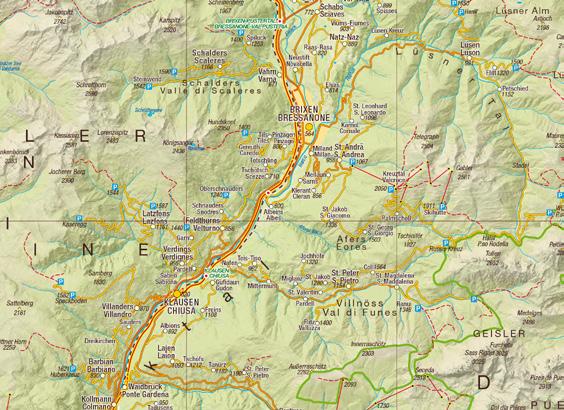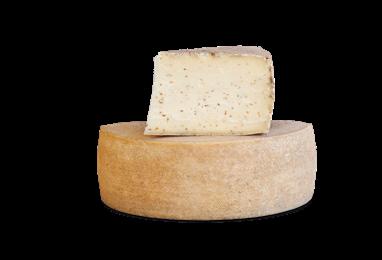
7 minute read
New and Approved News from the region
NEW AND APPROVED
News from the region
Advertisement


Hans Kammerer from Bressanone/ Brixen has drawn topographic and thematic maps as well as panoramic maps for more than thirty years. The 86-year-old is a self-taught mapmaker and a true pioneer of his trade.
Secrets of… a Cartographer
“I’VE BEEN interested in cartography since I was ten years old, and I’ve been gradually teaching myself ever since. The first maps I ever held in my hand were from the post-war era—with a 1:100,000 scale. And while they were good, I wanted more detail. I drew my first 1:25,000-scale topographic map by hand in 1960, using pen and ink and tempera. Nowadays we have software for that, of course. I’ve worked with computers for 30 years, and I’ve witnessed the entire technical evolution first-hand. I did not make a living from cartography until the 1990s. Until then, I had my tobacco shop and newsagent’s in the old town of Bressanone. I made new contacts, learned a lot about maps, and I worked in trail management for the Alpine Club for 40 years. When my first major commission arrived, I checked each position in person and walked a lot of trails myself. I roamed the mountains of South Tyrol and beyond for decades, all in the name of cartography. These days I draw panoramic maps in Photoshop, with the help of Google Maps images. By now everything has been surveyed by GPS.”
B is for… Birmehl
“BIR” is South Tyrolean for “pear”. In Verdignes/Verdings, the pear trees grow right in the middle of the village. Birmehl—pear flour—used to be an affordable alternative to sugar for the farmers of Verdignes. Producing this sweetening agent was a complicated, tedious process: the pears were dried and then ground into pear flour. While “Birmehldorf” (“pear flour

village”) used to be a somewhat derisive moniker for Verdignes, the locals today are proud to revive that tradition. They have even dedicated a themed trail and a festival to it: during the pear flour autumn festival, Birmehlherbst, their inns and Buschenschank taverns give the typical South Tyrolean dishes a touch of sweetness using pear flour.
500 Summits
… 498, 499, 500. In clear weather, a whopping five hundred peaks can be seen from the 360-degree viewing platform at the summit of the 2,512-metre-high Gitschberg mountain. They include a number of three-thousanders, the Dolomites, the Brenta Group, and the Zillertal, Stubai, and Ötztal Alps. This unique panoramic experience is just a few steps away from the upper terminus of the quad chairlift in the Rio Pusteria/Gitschberg Jochtal skiing area.

The Lord of the Slopes

FRANZ STABLUM is a farmer at the Niederthalerhof in Meluno/Mellaun. But for almost 40 years, the Plose mountain has been his second home. He has worked in the skiing region since December 1980, starting out as a lift technician at the old gondola lift. Today he is in charge of all the slopes. A lot has changed over the decades. The Trametsch slope, the showpiece of the Plose, is the longest downhill run in South Tyrol: nine kilometres long, with a difference in altitude of 1,400 metres. “We used to prepare the Trametsch only once a week”, Franz Stablum tells us. “That would be completely unthinkable today.” Together with his team, he makes sure every day that skiers find 40 kilometres of beautiful slopes when they arrive. While skiers prefer the Plose in sunny weather, he also sets out to work in the cold and the mist. But he still loves the mountains and the view as much as he did on his first day. Franz Stablum’s insider tip: “The evening mood at the Schönjöchl peak in summer. The sunset is gorgeous.”
Did You Know... ... that Chestnuts Are an Aphrodisiac?

Even back in the Middle Ages, chestnuts—seasoned with salt and pepper—were used as an aphrodisiac. They were supposed to boost the libido and improve potency. And in the early 20th century, researchers investigated the beguiling smell of chestnut blossoms. The pheromones contained in the scent of the blossoms make it an odor aphrodisiacus, said to influence the sex drive. However, back then, only the upper classes used chestnuts for pleasure gain, and they did so in secret.

Biking in Bressanone
THE BRESSANONE/BRIXEN BIKEPARK on the Plose mountain was inaugurated officially in 2018. Mountain bikers can choose from four lines of varying degrees of difficulty, with rapid downhill runs and far jumps. All lines can be reached from S. Andrea/St. Andrä via the Plose cable car: they start at the upper terminus. In addition, the Palmschoß chairlift is in operation to take bikers back uphill.
Length: 4.2 km Difference in altitude: 300 m Average grade: 7%
Hammer Line
Length: 1.9 km
Difference in altitude: 165 m
Average grade: 8.5%
Palm Pro Line
Length: 2.5 km
Difference in altitude: 265 m Average grade: 11%
Sky Line
Length: 6.6 km Difference in altitude: 900 m
Average grade: 13%
Riding the Express
A NUMBER OF new developments can be seen in the Rio Pusteria/Gitschberg Jochtal skiing area: the modern, high-comfort ten-seater gondola lift “Ski Express” with a capacity of 3,000 passengers per hour has replaced the older “Breiteben” and “Segerwiese” lifts. Thanks to a midway station, the popular and easy Breiteben slope remains accessible to beginners. Other new additions include the newly prepared two-kilometre-long “Wastl Huber” slope and the “Gimmy Fun Ride” in Valles-Jochtal: a 1.5-kilometre-long family-friendly winter sports adventure featuring easy jumps, obstacles, and banked turns.

The New Säben Promenade

Archaic, imposing, beautiful Säben Abbey towers high over Chiusa/Klausen. The Säben Promenade leading from the medieval artists’ town up to the abbey has undergone a makeover. The path up to the “Acropolis of Tyrol” is lined with new, specially designed benches called “Säbener Bankln” and a resting spot in the heart of the historic wine-growing area. From the abbey itself, the view of the mountains and valleys is marvellous. Information boards telling strollers all about the importance of the abbey as an episcopal see are scattered along the path.
That’s So Cheesy
THE REGION OF wine, speck, and dumplings? Yes, but also the region of cheese. The fine cheese factory Capriz is a show dairy, theme park, and bistro all rolled into one. This is where goat and cow milk is processed into soft cheese with exterior mould, double mould, or red smear, “Caprizella” mozzarella, cream cheese, and hard cheese. Visitors to the theme park can learn all about the process that turns milk into cheese. That cheese can then be tasted in the bistro, paired with an excellent wine and other selected delicacies.

www.capriz.bz
Advantage Cards
Fee-based cards:
+ The Mobilcard provides unlimited use of all public transport in South Tyrol.
+ The museumobil Card is available for a three- or seven-day period and includes unlimited use of public transport in South Tyrol as well as one admission each to the museums of South Tyrol.
+ The bikemobil Card entitles the card holder to unlimited use of buses, trains, and rental bikes in the entire region.
Free cards (included in the room rate at participating hotels and accommodation):
+ The BrixenCard offers free access to public transport, museums, and castles in South Tyrol, one admission to the Acquarena adventure pool in Bressanone/ Brixen, one journey on the Plose cable car, and an extensive cultural and hiking programme.
+ The Almencard is valid in the Rio Pusteria/Gitschberg Jochtal area as well as in Naz-Sciaves/ Natz-Schabs and offers free cable car journeys, a hiking programme, child and family activity programmes, as well as price reductions for museums, huts, and restaurants (not in winter). The Almencard Plus has additional perks: free public transport in South Tyrol, one admission each to the South Tyrol museums, and a hiking programme in NazSciaves.
+ The Klausen Card – alps & wine combines the museumobil Card with offers for Chiusa/ Klausen: free admission to three public pools, cable car journeys, summer and winter hiking shuttle buses, guided tours, wine and grappa tastings, and many more.










